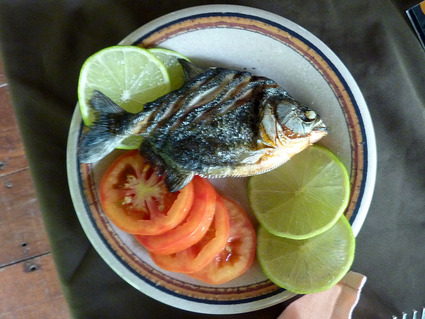
Are piranha fish edible and what do they taste like cooked
 In the Amazon region of South America, where piranhas are most commonly consumed, they are an important source of protein for many communities. The fish are often caught by hand or with nets, and then prepared for consumption. Piranhas are typically gutted and cleaned, and then either cooked whole or filleted before cooking.
In the Amazon region of South America, where piranhas are most commonly consumed, they are an important source of protein for many communities. The fish are often caught by hand or with nets, and then prepared for consumption. Piranhas are typically gutted and cleaned, and then either cooked whole or filleted before cooking.Piranhas are typically prepared by cleaning and gutting them, and then either grilling or frying them whole. Some people also fillet the fish before cooking. In the Amazon, piranhas are often cooked over an open flame, on a stick or skewer, with various seasonings and spices added for flavor.
When cooked, piranha flesh is said to have a firm, white texture that is mild and slightly sweet in flavor. Some people describe the taste as similar to tilapia or catfish, which are also freshwater fish. However, because piranhas are carnivorous and feed on other fish, their flesh can sometimes have a slightly gamey taste.
Piranhas are not commonly served in restaurants outside of the Amazon region, but they can sometimes be found in specialty seafood markets. In the Amazon, piranha is often sold at local markets and eaten in homes or small restaurants. Some popular preparations include grilling or frying the fish whole, or cooking them in soups or stews with vegetables and spices.
How to prepare piranha for grilling or frying
 To prepare piranha for grilling or frying, the fish is typically cleaned and gutted, then seasoned with salt, pepper, and other spices. It can then be cooked whole or filleted, depending on the preference of the cook. Grilling or frying the fish helps to crisp up the skin and bring out the flavor of the flesh.
To prepare piranha for grilling or frying, the fish is typically cleaned and gutted, then seasoned with salt, pepper, and other spices. It can then be cooked whole or filleted, depending on the preference of the cook. Grilling or frying the fish helps to crisp up the skin and bring out the flavor of the flesh.In addition to the fish itself, piranha dishes in Peru are often served with a variety of sides. One common side dish is tacacho, which is made from mashed green plantains that are fried until crispy. Another popular side is yuca, which is a starchy root vegetable that is boiled or fried and often served with a spicy dipping sauce. Other traditional sides may include rice, beans, and vegetables like peppers and tomatoes.
Piranha fish can also be used in soups and stews in Peru, where they are often cooked with vegetables like plantains, yuca, and corn. These dishes are often served with rice or other starches.
Overall, piranha dishes in Peru are often hearty and flavorful, featuring a mix of protein, starches, and vegetables. They are a popular choice for those looking to try traditional Peruvian cuisine, and can be found in restaurants throughout the country, particularly in the Amazon region. Read more about a Piranha Receipe called "Piranha a la Parrilla" or Grilled Piranha instructions and ingredients.
Overall, while piranha may have a reputation as a dangerous fish, they are also an important food source for many people living in the Amazon region, and can be a delicious and nutritious addition to the diet.
In terms of nutritional value, piranha fish are a good source of protein, omega-3 fatty acids, and various vitamins and minerals. The exact nutritional content of piranha will depend on the species, as well as factors like the age and size of the fish.
One study of two species of piranha found that they had high levels of protein, with 20-25 grams of protein per 100 grams of flesh. They also contained significant amounts of omega-3 fatty acids, which are important for heart health and brain function. In addition, piranhas were found to be a good source of vitamins B12 and D, as well as minerals like calcium and phosphorus.
While piranha may not be widely consumed outside of the Amazon region, they are an important source of nutrition for many communities in the area. In addition to their nutritional value, they are also considered a delicacy by some, and can be a tasty addition to a meal. However, it's important to note that some species of piranha are protected, and it's important to only consume piranhas that are caught sustainably and legally.